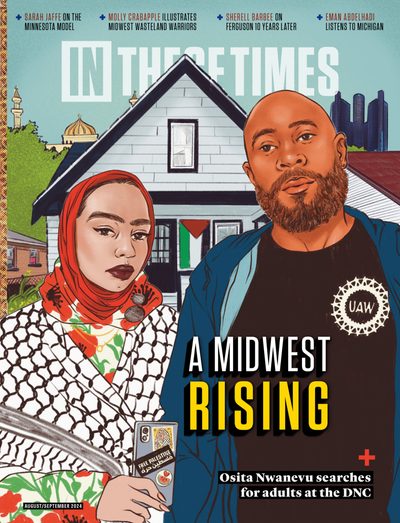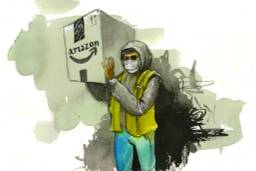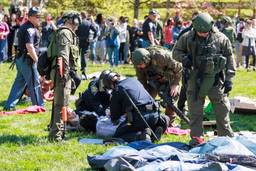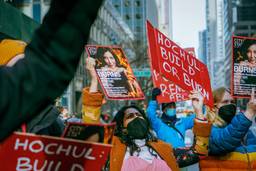Wasteland Warriors
“I showed up for East Palestine because I realized we are not alone.”
Maximillian Alvarez and Molly Crabapple

A sacrifice zone — an area permanently damaged by industrial impacts and societal disinvestment — can look just like any other ZIP code. You’ve probably stood in the middle of one without knowing it. You and your family might even be living in one right now. Your health may have already been forfeited by some suits in a boardroom, your lives written off as collateral damage.
Time will tell; our bodies keep score. Public policy bioaccumulates.
The hazardous living conditions in many U.S. sacrifice zones are often not as obvious as the exhaust belching from the menacing petrochemical plants of Louisiana’s Cancer Alley. The water coming out of the taps still looks like water, the air still looks like air. More often, the monstrous dangers are hiding in plain sight, and the signs that something is deeply wrong are, instead, scrawled on flesh and scarred on psyches: wheezing lungs, nosebleeds, surgically removed colons, fish floating downstream belly up, rare cancers, kids who are sick most of the time, lethargy, animals writhing with unexplained seizures, PTSD, birth defects, dead cattle, stress, more stress, and piles and piles of medical bills.
Increasing numbers of us are being set up for sacrifice across the country, and the Midwest has some of the most polluted states and highest concentrations of federal Superfund sites. Ohio has 37; Michigan, 65.
What’s even more scandalous is the number of communities poisoned by industries, private and public, that have been left off the Environmental Protection Agency’s National Priorities List. So the raw number of federal Superfund sites only tells part of the story; the people living, working and dying in these areas tell the rest.
But in these largely forgotten wastelands, you will find working people fighting the hardest for justice and accountability, even as their lives and communities are being sacrificed. Out of the toxic morass of our deregulated dystopia, wasteland warriors are emerging, and they need our help.
For this special issue of In These Times, titled “A Midwest Rising,” I teamed up with artist Molly Crabapple to highlight the heroic, unsung work of some of the amazing wasteland warriors continuing to fight against the pollution, destruction and corporate killing in the Midwest and beyond.
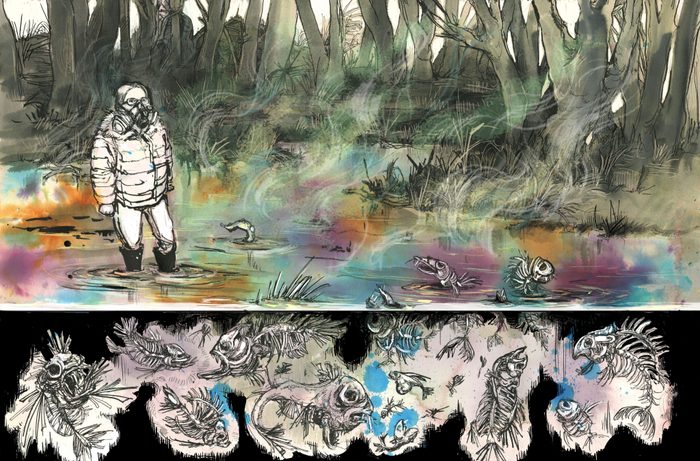
One such person is Christina Siceloff of South Beaver Township in Pennsylvania. Christina lives just six miles from East Palestine, Ohio, where a Norfolk Southern “bomb train” derailed on Feb. 3, 2023. Three days later, Norfolk Southern pressured local authorities to empty the contents of five rail cars — holding more than 100,000 gallons of toxic vinyl chloride — into a trench and set it on fire.
The “vent and burn” released a massive plume of smoky death, and people like Siceloff have had to square hollow assurances that everything is fine with proof that it’s not.
“A feeling in my esophagus and lungs, throat, nose and abdomen like someone was burning me with acid and lighting me on fire from the inside … nausea, vomiting and diarrhea … abnormal menstruation, cramping … twitches, tremors, anxiety and panic attacks,” Siceloff told me.
Siceloff has joined a number of locals to form a watchdog group known as the Creek Rangers. With her Wellington boots and a pink gas mask, Siceloff routinely wades into the creeks and ponds around East Palestine to inspect the cleanup process and document when the contaminants that are supposed to be gone are still there, lurking in the water and the sediment. You can see them when she plunges her spade into the creek bed and turns the soil over — they float like ghosts to the surface in whitish whisps.
In Clairton, Pa., a deindustrialized Rust Belt town about a 90 minute drive from East Palestine, residents have been sacrificed for generations. The town has lost nearly 70% of its population since the heyday of U.S. Steel in the 1950s, and more than 23% of residents live below the federal poverty line. Meanwhile, the town’s poor and working-class neighborhoods are plagued by gun violence and economic dead ends, and the air quality is consistently ranked among the worst in the nation, largely because of pollution from U.S. Steel’s Clairton Coke Works plant.
The majority of Clairton’s Black residents, who make up about 40% of the population, live in the shadow of Clairton Coke Works, and the airborne byproducts of coke production, according to Quinn Glabicki who was reporting for PublicSource, are known to cause “asthma, chronic obstructive pulmonary disease, heart disease and cancer.”
Melanie Meade’s family home sits on the top of a hill overlooking the plant. Meade has become a tireless environmental justice activist and fierce community advocate, educating others about the harm being done and trying to hold U.S. Steel accountable. And she has had to sacrifice so much.
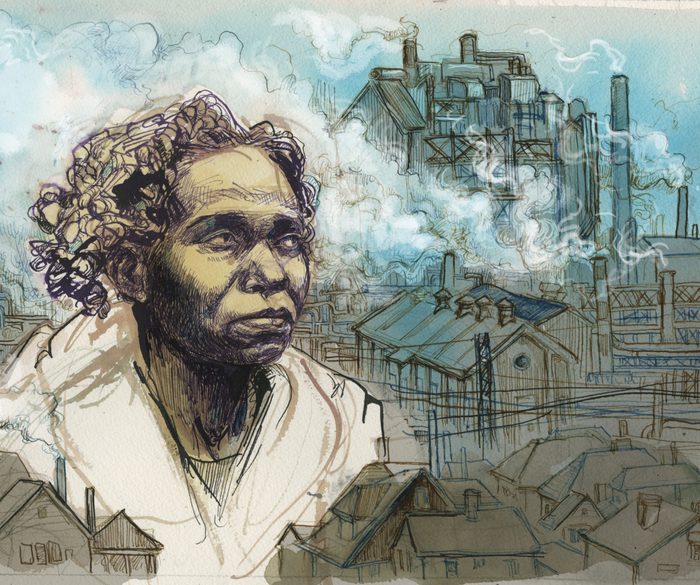
“In 2011, I buried my eldest brother,” Meade wrote in 2020. “He was a 45-year-old recovering addict with heart valve failure. In 2013, my father passed away at 73. He had heart problems. … Six months after my father’s death, my mother passed.
In 2015, I lost my eldest sister to lung cancer. She was 55.” Earlier this year, Meade’s son, Robert Wellington III, was murdered.
Still, somehow, living in such toxic and violent conditions, enduring such unimaginable loss, Meade keeps fighting.
“Many people are just getting by,” Meade said, “so there is little energy left over after living in sacrifice zones with high crime rates and with little unity.”
But that is also why Meade has found hope connecting with residents of other sacrifice zones, like those in East Palestine, where she traveled in March, one month after losing her son. “I showed up for East Palestine, because,” she said, “I realized we are not alone, and different industries harming our health are doing the same thing, no matter if it is coking coal or transporting harmful chemicals.”
Vina Colley, president of Portsmouth/Piketon Residents for Environmental Safety and Security, feels similarly, and she too has been a vocal advocate for her poisoned neighbors in East Palestine. Vina is an elder of the struggle, fighting for more than 40 years to hold the Portsmouth Gaseous Diffusion Plant in Pike County, Ohio, accountable for knowingly exposing her, her coworkers and her neighbors to poisonous radioactive material — and fighting to ensure the government compensates the generations of residents it has summarily sacrificed in Pike and Scioto counties. The “A-plant,” as locals call it, is a Department of Energy site; it began operating in 1954.
“The plant was one of three large gaseous diffusion plants in the United States initially constructed to produce enriched uranium to support the nation’s nuclear weapons program,” according to the Department of Energy, “and, in later years, enriched uranium used by commercial nuclear reactors.”
Colley was hired as an electrician at the plant, where she and her coworkers were routinely exposed to radioactive material. “I was only there from 1980 to 83 before I started really getting sick,” she said. “I was exposed to everything. We were cleaning off radioactive equipment that we did not know was radioactive. They never told us,” she explained to Belt Magazine in 2020.
Since, Colley has suffered a litany of health problems, including chronic bronchitis, tumors and pulmonary edema. For years, she’s watched her former coworkers and community members die, one by one, from cancer. “It’s heartbreaking to watch these little kids and people in your community getting cancer or dying with cancer. … We are being used as human experiments here. This is a sacrifice zone.”
Still, somehow, Colley — like Siceloff in East Palestine and Meade in Clairton — keeps fighting.
The wholesale sacrifice of entire communities should be unfathomable. And yet, after decades of virtually unchecked capitalist pillage, America’s sacrifice zones are not extreme outliers. They are, in fact, a harrowing model of the future if the corporate monsters, corporate politicians and Wall Street vampires responsible are not stopped.
And it’s us, the ones in their path — working people, fighting as one — who are going to stop them.
Maximillian Alvarez is editor-in-chief at the Real News Network and host of the podcast Working People, available at InTheseTimes.com. He is also the author of The Work of Living: Working People Talk About Their Lives and the Year the World Broke.
Molly Crabapple, an artist and writer in New York, is the author of, most recently, Drawing Blood and Brothers of the Gun, (with Marwan Hisham). Her art is in the permanent collections of the Museum of Modern Art. Her animated short, A Message from the Future with Alexandria Ocasio-Cortez, has been nominated for a 2020 Emmy for Outstanding News Analysis: Editorial and Opinion.
